 W
WAaveqaspis is a genus of small marine arthropods of unclear affiliation, that lived during the early Cambrian period. Fossil remains of Aaveqaspis were collected from the Lower Cambrian Sirius Passet fossil-Lagerstätte of North Greenland. Aaveqaspis looks like a soft eyeless trilobite with a weakly defined axis, a headshield with stubby genal spines, 5 thorax segments also ending in stubby genal spines, and a tailshield (pygidium) with a pair of massive tusk-like spines, and two smaller spines near the end of the axis. The only species presently known is A. inesoni.
 W
WAcanthomeridion is an extinct arthropod found in the Chengjiang fauna deposits of China. In 1997, it was placed in its own, monotypic family, Acanthomeridiidae. It is known from eight specimens, all found in China.
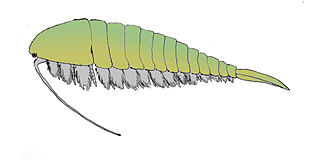 W
WAlalcomenaeus is one of the most widespread and longest-surviving arthropod genera of the Early and Middle Cambrian. Known from over 300 specimens in the Burgess Shale, and the Chengjiang, it bears great similarity to the opabiniids.
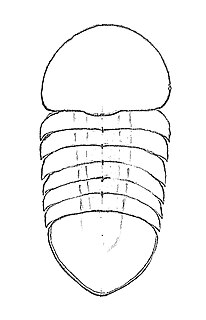 W
WBuenaspis is a genus of small marine arthropods in the family Liwiidae, that lived during the early Cambrian period. Fossil remains of Buenaspis were collected from the Lower Cambrian Sirius Passet Lagerstätte of North Greenland. Buenaspis looks like a soft eyeless trilobite. It has a headshield slightly larger than the tailshield (pygidium), and in between them six thoracic body segments (somites). The genus is monotypic, its sole species being Buenaspis forteyi.
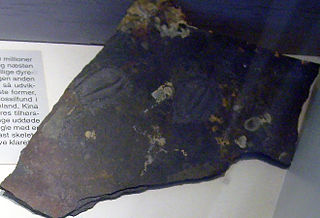 W
WBuenellus higginsi is an average size trilobite, which lived during the Lower Cambrian period, in what is now North-West Greenland. It is a prominent member of the Sirius Passet fauna. Buenellus higginsi is the only known species in the genus Buenellus.
 W
WBurgessia is an extinct genus of arthropod from the Middle Cambrian. Its fossils have been found in the Burgess Shale in British Columbia, Canada. Many of its fossils have been found. 1383 specimens of Burgessia are known from the Greater Phyllopod bed, where they comprise 2.63% of the community.
 W
WCanadaspis is an extinct genus of Cambrian-aged crustacean or euarthropod, a benthic feeder that moved mainly by walking and possibly used its biramous appendages to stir mud in search of food. The genus has been placed within the subclass Phyllocarida, in the class Malacostraca that includes shrimps and lobsters.
 W
WCarnarvonia is a genus of arthropods of uncertain affinities, known from the Middle Cambrian Burgess Shale. Its bivalved carapace bears the imprints of its veins.
 W
WDouglasocaris is a genus of Notostraca fossil from the Middle Ordovician Douglas Lake Member of the Lenoir Limestone from Douglas Dam Tennessee.
 W
WEmeraldella is a genus of arthropod known from the Middle Cambrian of North America. The type species E. brocki was described in 1912 from the Burgess Shale. 21 specimens of Emeraldella are known from the Greater Phyllopod bed, where they comprise < 0.1% of the community. A re-study on the species was done in 2012. A second species E. brutoni is known from the Wheeler Shale, which was described in 2011. An additional specimen of E. brutoni was described in 2019, which revealed more of the anatomy.
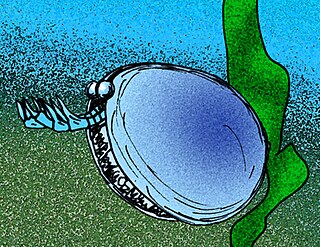 W
WForfexicaris valida is a species of Lower Cambrian arthropod, the only species in the family Forfexicarididae. It is known from only two specimens from the Maotianshan shale Lagerstätte.
 W
WFurca is an extinct genus of Marrellomorph arthropod known from the Sandbian stage of the Czech Republic. At least three distinct species have been described although they may all be synonyms of the type species, Furca bohemica. A tentative additional species, "Furca mauretanica": was proposed for specimens discovered in Morocco, but this species remains a nomen nudum until formally published.
 W
WFuxianhuia is a genus of Lower Cambrian fossil arthropod known from the Chengjiang fauna in China. Its purportedly primitive features have led to its playing a pivotal role in discussions about the euarthropod stem group. Nevertheless, despite being known from many specimens, disputes about its morphology, in particular its head appendages, have made it one of the most controversial of the Chengjiang taxa, and it has been discussed extensively in the context of the arthropod head problem.
 W
WHabelia is an genus of extinct arthropod from the Middle Cambrian. Its fossils have been found in the Burgess Shale in British Columbia, Canada. Fifty-four specimens of Habelia are known from the Greater Phyllopod bed, where they comprise 0.1% of the community. While previously enigmatic, a 2017 restudy found that it formed a clade (Habeliida) with Sanctacaris, Utahcaris, Wisangocaris and Messorocaris as a stem-group to Chelicerata.
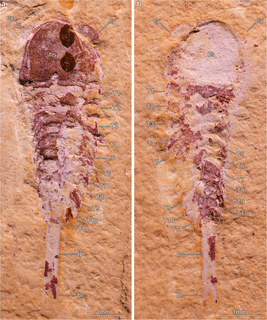 W
WJianshania is genus of Cambrian arthropod known from the Chengjiang biota, containing the single species J. furfactus. It was described by Luo et al in 1999. In 2020, a specimen originally assigned to the species was found to represent the separate fuxianhuiid taxon Xiaocaris pending revision of the type specimen.
 W
WKerygmachela kierkegaardi was a gilled lobopodian from the Buen Formation of the Sirius Passet Lagerstätte, in northern Greenland. Its anatomy strongly suggests that it, along with its relative Pambdelurion whittingtoni, was a close relative of anomalocaridid (radiodont) and euarthropod. The specific name, "kierkegaardi" honors Danish philosopher Søren Kierkegaard.
 W
WLeanchoilia is an megacheiran arthropod known from Cambrian deposits of the Burgess Shale in Canada and the Chengjiang biota of China. It was about 5 centimetres (2.0 in) long and had long, whip-like feelers mounted on frontal arm-like appendages. Its internal organs are occasionally preserved within the substrate in three dimensions.
 W
WLyrarapax is a radiodont of the family Amplectobeluidae that lived in the early Cambrian period 520 million years ago. Its neural tissue indicates that the anomalocaridid frontal appendage is protocerebral, resolving parts of the arthropod head problem and showing that the frontal appendage is homologous to the antennae of Onychophorans and labrum of euarthropods. Its fossilized remains were found in Yunnan in southwestern China. A second species was described in 2016, differing principally in the morphology of its frontal appendages.
 W
WMollisonia is a genus of epifaunal detritivorous arthropod. Species are known from the Cambrian Burgess Shale, Langston Formation and Wheeler Shale of North America, as well and the Chenjiang Biota of China. Twenty-one specimens of Mollisonia are known from the Greater Phyllopod bed, where they comprise less than 0.1% of the community. Remains attributed to the genus are also known from the Ordovician Fezouata Formation of Morocco and Greenland. An observation published in 2019 suggest this genus is a basal chelicerate, closer to crown group chelicerata than members of Habeliida. It is suggested to be closely related to Corcorania, Ecnomocaris and Thelxiope, together forming the clade Mollisoniida.
 W
WOccacaris oviformis is an extinct nektonic predatory arthropod from the Lower Cambrian Maotianshan shale Lagerstätte. It bears a superficial resemblance to the Cambrian arthropod, Canadaspis, though, was much smaller, and had a pair of "great appendages", with which it may have grasped prey.
 W
WPambdelurion whittingtoni is an extinct, nektonic organism from the Sirius Passet Lagerstätte, from Cambrian Greenland. Its anatomy strongly suggests that it, along with its relative Kerygmachela kierkegaardi, was either an anomalocarid or a close relative thereof.
 W
WPlenocaris plena is a crustacean-like arthropod with a bivalved carapace, and is known from the Burgess shale and Chengjiang. 106 specimens of Plenocaris are known from the Greater Phyllopod bed, where they comprise 0.20% of the community.
 W
WPrimicaris is genus of Cambrian arthropod from the Chengjiang biota, containing the single species P. larvaformis. Its specimens were once thought to be meraspids of Naraoia spinosa. It is also known from the Burgess Shale, its phylogenetic position has been described as "problematic".
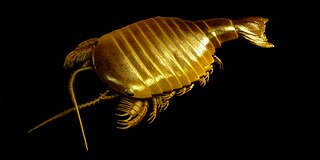 W
WSidneyia is an extinct arthropod known from fossils found from the Early Cambrian-age Maotianshan Shales to the Mid Cambrian Burgess Shale formation of British Columbia. 144 specimens of Sidneyia are known from the Greater Phyllopod bed, where they comprise 0.27% of the community.
 W
WTamisiocaris is an anomalocaridid taxon initially only known from frontal appendages from the Buen Formation in Sirius Passet. Further specimens revealed that the frontal appendages were segmented and bearing densly-packed auxiliary spines, which were adapted to suspension feeding in a manner analogous to modern baleen whales.
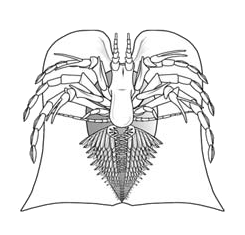 W
WVachonisia is a Devonian marrellomorph known from the Lower Devonian Hunsrück Shale. It grows in a similar fashion to the other Hunsruck marrellomorph, Mimetaster, and is closely related to the Silurian Xylokorys. It is known from 20 specimens; its whole body is covered by a shield-like carapace.
 W
WWaptia fieldensis is an extinct species of arthropod from the Middle Cambrian Burgess Shale Lagerstätte of Canada. It grew to a length of about 8 cm (3 in) and resembled modern shrimp in both morphology and habit. It had a large bivalved carapace and a segmented body terminating into a pair of tail flaps. It was an active swimmer, feeding on organic particles it gathered from the seafloor substrate. It is also one of the oldest animals with direct evidence of brood care.
 W
WWillwerathia is a genus of synziphosurine, a paraphyletic group of horseshoe crab-like fossil chelicerate arthropods. Willwerathia known only by one species, Willwerathia laticeps, discovered in deposits of the Devonian period from the Rhenish Slate Mountains of Germany.
 W
WWorthenella is a genus of stem-group arthropod from the Burgess Shale. Charles Doolittle Walcott named the species in 1911. In 2013, David Legg placed it in the family Kootenichelidae as a sister to Kootenichela.
 W
WYawunik is an extinct genus of Cambrian arthropod known from the Burgess Shale in Canada. The type species has been named Yawunik kootenayi after the Kootenay, both a geographic area and North American First Nation, also known as the Ktunaxa. The fossil dates back to 508 million years ago.
 W
WYohoia is a genus of tiny, extinct animals from the Cambrian period that has been found as fossils in the Burgess Shale formation of British Columbia, Canada. It has been placed among the arachnomorpha, a group of arthropods that includes the chelicerates and possibly the trilobites. Their sizes range from 7 to 23 mm. 711 specimens of Yohoia are known from the Greater Phyllopod bed, where they comprise 1.35% of the community.